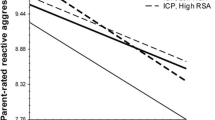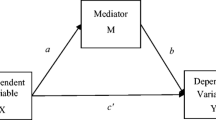Abstract
Prior research suggests that under some conditions, interventions that aggregate high-risk youth may be less effective, or at worse, iatrogenic. However, group formats have considerable practical utility for delivery of preventive interventions, and thus it is crucial to understand child and therapist factors that predict which aggressive children can profit from group intervention and which do not. To address these questions we video-recorded group Coping Power intervention sessions (938 sessions), coded both leader and participant behavior, and analyzed both leader and children’s behaviors in the sessions that predicted changes in teacher and parent, reports of problem behavior at 1-year follow up. The sample included 180 high-risk children (69% male) who received intervention in 30 separate Coping Power intervention groups (six children assigned per group). The evidence-based Coping Power prevention program consists of 32 sessions delivered during the 4th and 5th grade years; only the child component was used in this study. The behavioral coding system used in the analyses included two clusters of behaviors for children (positive; negative) and two for the primary group leaders (group management; clinical skills). Growth spline models suggest that high levels of children’s negative behaviors predicted increases in teacher and parent rated aggressive and conduct problem behaviors during the follow-up period in the three of the four models. Therapist use of clinical skills (e.g., warmth, nonreactive) predicted less increase in children’s teacher-rated conduct problems. These findings suggest the importance of clinical training in the effective delivery of evidence-based practices, particularly when working with high-risk youth in groups.


Similar content being viewed by others
Notes
In follow-up exploratory analyses of the two predictors of teacher-rated Conduct Problems, conducted because of potential colinearity due to significant correlations among predictors, three HLM analyses using on predictor were conducted. When only child negative behavior was used as a predictor, negative behavior significantly predicted the slope for Conduct Problems, T (118) = 2.68, p = 0.008. When only leaders’ Clinical Skills was as a predictor, Clinical Skills significantly predicted the slope for Conduct Problems, T (28) = −2.28, p = 0.03. When only leaders’ Group Management behaviors was a predictor, Group Management did not significantly predict the slope for Conduct Problems, T (28) = −0.54, p = 0.59. Thus, the pattern of predictors in single-predictor models for teacher-rated Conduct Problems exactly paralleled the results for the full model tested.
References
Almirall, D., Nahum-Shani, I., Sherwood, N. E., & Murphy, S. A. (2014). Introduction to SMART designs for the development of adaptive interventions: with applications to weight loss research. Translational Behavioral Medicine, 4, 260–274.
Baumrind, D. (1971). Current patterns of parental authority. Developmental Psychology Monograph, 4, 1–103.
Boxmeyer, C., Powell, N. P., Lochman, J. E., Dishion, T. J., Wojnaroski, M., & Winter, C. (2015). Cognitive-behavioral group coding system . Tuscaloosa: University of Alabama.Unpublished manuscript
Brabender, V. (2002). Introduction to group therapy. New York: Wiley.
Chapman, C. L., Baker, E. L., Porter, G., Thayer, S. D., & Burlingame, G. M. (2010). Rating group therapist interventions: the validation of the group psychotherapy intervention rating scale. Group Dynamics: Theory, Research, and Practice, 14, 15–31.
Cho, H., Hallfors, D. D., & Sánchez, V. (2005). Evaluation of a high school peer group intervention for at-risk youth. Journal of Abnormal Child Psychology, 33, 363–374.
Dishion, T. J., & Andrews, D. W. (1995). Preventing escalation in problem behaviors with high-risk young adolescents: immediate and 1-year outcomes. Journal of Consulting and Clinical Psychology, 63, 538–548.
Dishion, T. J., & Dodge, K. A. (2006). Deviant peer contagion in interventions and programs: an ecological framework for understanding influence mechanisms. In K. A. Dodge, T. J. Dishion, & J. E. Lansford (Eds.), Deviant peer influences in programs for youth: problems and solutions (pp. 14–43). Guilford: New York.
Dishion, T. J., McCord, J., & Poulin, F. (1999). When interventions harm: peer groups and problem behavior. American Psychologist, 54, 755–764.
Dishion, T. J., & Patterson, G. R. (2016). The development and ecology of antisocial behavior: linking etiology, prevention, and treatment. In D. Cicchetti (Ed.), Developmental psychopathology, volume 3, maladaptation and psychopathology (3rd ed., pp. 647–678). Hoboken, New Jersey: Wiley.
Dishion, T. J., Poulin, F., & Burraston, B. (2001). Peer group dynamics associated with iatrogenic effect in group interventions with high-risk young adolescents. New Directions for Child and Adolescent Development, 91, 79–92.
Dodge, K. A., Dishion, T. J., & Lansford, J. E. (2006). Deviant peer influences in intervention and public policy for youth. Social Policy Report, 20, 1–19.
Doyle, A., Ostrander, R., Skare, S., Crosby, R. D., & August, G. J. (1997). Convergent and criterion-related validity of the behavior assessment system for children-parent rating scale. Journal of Clinical Child Psychology, 26, 276–284.
Ellis, M. L., Lindsey, M., Barker, E. D., Boxmeyer, C. L., & Lochman, J. E. (2013). Predictors of engagement in a school-based family preventive intervention for youth experiencing behavioral difficulties. Prevention Science, 14, 457–467.
Henry, W. P., Strupp, H. H., Butler, S. F., Schacht, T. E., & Binder, J. L. (1993). Effects of training in time-limited dynamic psychotherapy: changes in therapist behavior. Journal of Consulting and Clinical Psychology, 61, 434–440.
Huh, D., Tristan, J., Wade, E., & Stice, E. (2006). Does problem behavior elicit poor parenting? A prospective study of adolescent girls. Journal of Adolescent Research, 21, 185–204.
Hurley, J. R. (1997). Interpersonal theory and measures of outcome and emotional climate in 111 personal development groups. Group Dynamics: Theory, Research and Practice, 1, 86–97.
Kazdin, A. E. (1992). Overt and covert antisocial behavior: child and family characteristics among psychiatric inpatient children. Journal of Child and Family Studies, 1, 3–20.
Lansford, J. E., Criss, M. M., Laird, R. D., Shaw, D. S., Pettit, G. S., Bates, J. E., & Dodge, K. A. (2011). Reciprocal relations between parents’ physical discipline and children’s externalizing behavior during middle childhood and adolescence. Development and Psychopathology, 23, 225–238.
Letendre, J., & Davis, K. (2004). What really happens in violence prevention groups? A content analysis of leader behaviors and child responses in a school-based violence prevention project. Small Group Research, 35, 367–387.
Lochman, J. E., & Allen, G. (1979). Elicited effects of approval and disapproval: an examination of parameters having implication for counseling couples in conflict. Journal of Consulting and Clinical Psychology, 47, 636–638.
Lochman, J. E., Baden, R. E., Boxmeyer, C. L., Powell, N. P., Qu, L., Salekin, K. L., & Windle, M. (2014). Does a booster intervention augment the preventive effects of an abbreviated version of the coping power program for aggressive children? Journal of Abnormal Child Psychology, 42, 367–381.
Lochman, J. E., Dishion, T. J., Powell, N. P., Boxmeyer, C. L., Qu, L., & Sallee, M. (2015). Evidence-based child preventive intervention for antisocial behavior: a randomized study of the effects of group versus individual delivery. Journal of Consulting and Clinical Psychology, 83, 728–735.
Lochman, J. E., Powell, N., Boxmeyer, C., Qu, L., Wells, K., & Windle, M. (2009). Implementation of a school-based prevention program: effects of counselor and school characteristics. Professional Psychology: Research and Practice, 40, 476–497.
Lochman, J. E., & Wells, K. C. (2002). Contextual social–cognitive mediators and child outcome: a test of the theoretical model in the coping power program. Development and Psychopathology, 14, 945–967.
Lochman, J. E., & Wells, K. C. (2003). Effectiveness of the coping power program and of classroom intervention with aggressive children: outcomes at a 1-year follow-up. Behavior Therapy, 34, 493–515.
Lochman, J. E., & Wells, K. C. (2004). The coping power program for preadolescent aggressive boys and their parents: outcome effects at the 1-year follow-up. Journal of Consulting and Clinical Psychology, 72, 571–578.
Lochman, J. E., Wells, K., & Lenhart, L. (2008). Coping power: child group facilitator's guide. New York: Oxford University Press.
Lochman, J. E., Wells, K. C., Qu, L., & Chen, L. (2013). Three-year follow-up of coping power intervention effects: evidence of neighborhood moderation? Prevention Science, 14, 364–376.
Loeber, R. (1982). The stability of antisocial and delinquent behavior: a review. Child Development, 53, 1431–1446.
McLean, P. D., Whittal, M. L., Thordarson, D. S., Taylor, S., Sochting, I., et al. (2001). Cognitive versus behavior therapy in the group treatment of obsessive-compulsive disorder. Journal of Consulting and Clinical Psychology, 69, 205–214.
McLeod, B. D., & Weisz, J. R. (2010). The therapy process observational coding system for child psychotherapy strategies scale. Journal of Clinical Child and Adolescent Psychology, 39, 436–443.
Muratori, P., Milone, A., Manfredi, A., Polidori, L., Ruglioni, L., Lambruschi, F., Masi, G., & Lochman, J.E. (in press). Evaluation of improvement in externalizing behaviors and callous-unemotional traits in children with Disruptive Behavior Disorder: A 1-year follow up clinic-based study. Administration and Policy in Mental Health and Mental Health Services.
Pavio, S. C. (2013). Essential processes in emotion-focused therapy. Psychotherapy, 50, 341–345.
Poulin, F., Dishion, T. J., & Burraston, B. (2001). 3-year iatrogenic effects associated with aggregating high-risk adolescents in cognitive-behavioral preventive interventions. Applied Developmental Science, 5, 214–224.
Raudenbush, S. W., & Bryk, A. S. (2002). Hierarchical linear models: applications and data analysis methods (2nd ed.). Thousand Oaks: Sage Publications.
Reynolds, C. R., & Kamphaus, R. W. (1992). Behavior assessment system for children: manual. Circle Pines: American Guidance Service.
Schuelke, M., Terry, R., & Day, E. (2013). Growth spline modeling. Cary: SAS http://support.sas.com/resources/papers/proceedings.
Snyder, J. J., Schrepferman, L. P., Bullard, L., McEachern, A. D., & Patterson, G. R. (2012). Covert antisocial behavior, peer deviancy training, parenting processes, and sex differences in the development of antisocial behavior during childhood. Development and Psychopathology, 24, 1117–1138.
Stewart, J. L., Christner, R. W., & Freeman, A. (2007). An introduction to cognitive-behavior group therapy with youth. In R. W. Christner, J. L. Stewart, & A. Freeman (Eds.), Cognitive-behavior group therapy with children and adolescents (pp. 3–21). New York: Routledge.
Weiss, B., Caron, A., Ball, S., Tapp, J., Johnson, M., & Weisz, J. R. (2005). Iatrogenic effects of group treatment for antisocial youths. Journal of Consulting and Clinical Psychology, 73, 1036–1044.
Zonnevylle-Bender, M. J., Matthys, W., & Lochman, J. E. (2007). Preventive effects of treatment of disruptive behavior disorder in middle childhood on substance use and delinquent behavior. Journal of the American Academy of Child & Adolescent Psychiatry, 46, 33–39.
Acknowledgments
This paper has been supported by grants from the National Institute of Drug Abuse (R01 DA023156) and the National Institute of Child Health & Human Development (R01 HD079273).
Author information
Authors and Affiliations
Corresponding author
Ethics declarations
Conflict of Interest
John Lochman is the co-developer of the Coping Power program, and he receives royalties from Oxford University Press for the implementation guides for this program.
Ethical Approval
All procedures performed in studies involving human participants were in accordance with the ethical standards of the institutional and/or national research committee and with the 1964 Helsinki declaration and its later amendments or comparable ethical standards.
Informed Consent
Informed consent was obtained from all individual participants included in the study.
Rights and permissions
About this article
Cite this article
Lochman, J.E., Dishion, T.J., Boxmeyer, C.L. et al. Variation in Response to Evidence-Based Group Preventive Intervention for Disruptive Behavior Problems: A View from 938 Coping Power Sessions. J Abnorm Child Psychol 45, 1271–1284 (2017). https://doi.org/10.1007/s10802-016-0252-7
Published:
Issue Date:
DOI: https://doi.org/10.1007/s10802-016-0252-7




